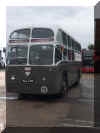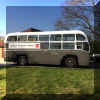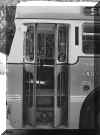 UMP277 is a 1949 AEC Regal IV
prototype with PRV B40F body that spent some with London Transport. It is
pictured here outside PRV's offices in Abbey Road as
"just built". This monochrome hand-coloured photograph was probably to be used for
a brochure (Image courtesy Ian McLellan-Smith). This vehicle has
now been restored see the restoration story
here.
UMP277 is a 1949 AEC Regal IV
prototype with PRV B40F body that spent some with London Transport. It is
pictured here outside PRV's offices in Abbey Road as
"just built". This monochrome hand-coloured photograph was probably to be used for
a brochure (Image courtesy Ian McLellan-Smith). This vehicle has
now been restored see the restoration story
here.


 This is the second Regal IV prototype with PRV body
dating August 1949 (Body No. B34156). Similar
to
UMP227 but RHD, It was delivered to Hague Tramways as their #96, but after further demonstration work,
it was sold in Britain in the mid 50's, becoming a roadside tea bar!
This is the second Regal IV prototype with PRV body
dating August 1949 (Body No. B34156). Similar
to
UMP227 but RHD, It was delivered to Hague Tramways as their #96, but after further demonstration work,
it was sold in Britain in the mid 50's, becoming a roadside tea bar!
 This is one of three photos
included in a feature in the January 1952 ACV Gazette about the MIRA Proving
Ground near Nuneaton. It is believed this LHD coach is on a Regal IV chassis
(No.
9831E002) that was shown on Park Royal's stand at the 1950 Commercial
Motor Show. Apparently the body was later transferred to Crossley
on the the Regal IV chassis (No. 9831E004) (image
and information kindly supplied by Neil Fraser of www.aecsouthall.co.uk).
This is one of three photos
included in a feature in the January 1952 ACV Gazette about the MIRA Proving
Ground near Nuneaton. It is believed this LHD coach is on a Regal IV chassis
(No.
9831E002) that was shown on Park Royal's stand at the 1950 Commercial
Motor Show. Apparently the body was later transferred to Crossley
on the the Regal IV chassis (No. 9831E004) (image
and information kindly supplied by Neil Fraser of www.aecsouthall.co.uk).
 A680 is a PRV
built coach (Body # B34585) built in June 1951 on an AEC Regal IV chassis (#
9821E370) for Linjebuss, Stockholm.
A680 is a PRV
built coach (Body # B34585) built in June 1951 on an AEC Regal IV chassis (#
9821E370) for Linjebuss, Stockholm.

 A728 is a PRV
built coach (Body # B34626) built in June 1951 on an AEC Regal IV chassis (#
9821E400) for Linjebuss, Stockholm.
A728 is a PRV
built coach (Body # B34626) built in June 1951 on an AEC Regal IV chassis (#
9821E400) for Linjebuss, Stockholm.

 A697 is a PRV
built coach (Body # B34593) built in July 1951 on an AEC Regal IV chassis (#
9821E377) for Linjebuss, Stockholm.
A697 is a PRV
built coach (Body # B34593) built in July 1951 on an AEC Regal IV chassis (#
9821E377) for Linjebuss, Stockholm.

 MLL738 is a PRV built coach (Body # B35271) built in February 1953 on an AEC
Regal IV chassis (# 9822E120) for BEA. Please see the
BEA page for further images and information (Images courtesy Roy Gould).
MLL738 is a PRV built coach (Body # B35271) built in February 1953 on an AEC
Regal IV chassis (# 9822E120) for BEA. Please see the
BEA page for further images and information (Images courtesy Roy Gould).
 Björn
Forslund
kindly sent in his photograph of the only remaining Park Royal bodied AEC Regal in
Sweden; built in
1952 this AEC Regal Mark IV was restored in the 80's by the Linjebuss company
(fleet No. 439) but when the company was bought by Connex in the
90's the bus was eventually donated to the the Svenska Omnibusföreningen (Swedish Omnibus
Association); the photo [©Björn Forslund], was taken at the Swedish 100 year celebration of the first regular bus
service at Malmkoping in 1999; at that time it was still was owned by Linjebuss/Connex company.
Please
visit the Svenska Omnibusföreningen (Swedish Omnibus
Association) website where you will find links to photos and descriptions of
their preserved buses (it's in Swedish but the Google toolbar translator
solves the issue for those like me! Ed.).
Björn
Forslund
kindly sent in his photograph of the only remaining Park Royal bodied AEC Regal in
Sweden; built in
1952 this AEC Regal Mark IV was restored in the 80's by the Linjebuss company
(fleet No. 439) but when the company was bought by Connex in the
90's the bus was eventually donated to the the Svenska Omnibusföreningen (Swedish Omnibus
Association); the photo [©Björn Forslund], was taken at the Swedish 100 year celebration of the first regular bus
service at Malmkoping in 1999; at that time it was still was owned by Linjebuss/Connex company.
Please
visit the Svenska Omnibusföreningen (Swedish Omnibus
Association) website where you will find links to photos and descriptions of
their preserved buses (it's in Swedish but the Google toolbar translator
solves the issue for those like me! Ed.).



 This
is the first of the only batch of thirty-nine Regal IVs (Fleet Nos. 290-328) with
Crossley built bodywork (see
note[1] below) that were all delivered in 1952 (except Fleet Nos. 312 &
325-8 that were delivered in early '53) to the Christchurch Transport Board in New Zealand.
Notice the series of hooks asymmetrically mounted above the AEC badge to the
front! If you are wondering their purpose see the picture below of a PRV version of this bus and perhaps be surprised? We believe the interior of the
driver's cabin (of either a Crossley or PRV version) of this bus can be seen here.
This
is the first of the only batch of thirty-nine Regal IVs (Fleet Nos. 290-328) with
Crossley built bodywork (see
note[1] below) that were all delivered in 1952 (except Fleet Nos. 312 &
325-8 that were delivered in early '53) to the Christchurch Transport Board in New Zealand.
Notice the series of hooks asymmetrically mounted above the AEC badge to the
front! If you are wondering their purpose see the picture below of a PRV version of this bus and perhaps be surprised? We believe the interior of the
driver's cabin (of either a Crossley or PRV version) of this bus can be seen here.
 This
Regal IV, fleet No. 331, with PRV bodywork (B35453 Range 51-68), was one of a
first batch of eighteen delivered in 1952/3 to the Christchurch Transport Board in New
Zealand. Though 331 was built in June 1952 to feature in the
September/October Commercial Motor Show at Earls Court it wasn't delivered to
CTB until April '53. (The photograph demonstrates New Zealand's unusual method of carrying perambulators!)
This
Regal IV, fleet No. 331, with PRV bodywork (B35453 Range 51-68), was one of a
first batch of eighteen delivered in 1952/3 to the Christchurch Transport Board in New
Zealand. Though 331 was built in June 1952 to feature in the
September/October Commercial Motor Show at Earls Court it wasn't delivered to
CTB until April '53. (The photograph demonstrates New Zealand's unusual method of carrying perambulators!)
The following anecdote has been kindly provided
by David Welch formerly of the Christchurch Transport Board:
I used to love the old
"Mark Fours", lumbering but very comfortable to drive, I think partly because of their
dependability, pre-select and the very
comfortable (sitting at a table feel) body position for driving. They ran for about 25 years in
Christchurch, not bad
for buses that often ran 18 hours a day most days. The bodies
were very heavy and solid. Sometimes I'd pat the bus when I came
alongside, it used to make me think of an elephant. They had such a low torque
I swear you could have driven up a hill in fourth gear and that no mud in the
world would ever bog down a Mark IV. It would just complacently "chew its cud"
and slowly turn over, and however slow, surely but steadily pull away. We would
continue driving them even when boiling over (that was the advice) up our main
hill route to the hose that was kept at the top - and boy watch out when you prized
off the radiator cap!
Strange as it may seem, I specifically
remember the 331 (pictured). I used to look out for it (if I had the
option of say taking a bus from the yard to do a special). For some reason
the steering and acceleration on the 331 seemed a lot lighter and peppier to handle
than most of the rest of the fleet! Amazing that the only one I specifically
remember should be the one in the photo.
I suspect the picture was actually a UK factory publicity photo as I
don't think there was ever a period when CTB provided dustcoats for drivers, always a full
uniform. It is a very nostalgic image nonetheless.
David
Frost comments:
Whilst in NZ I spotted an ex. Christchurch Hawke bodied Bristol RELL (Hawke produced ECW bodies under
licence). A local company (Bayline) bought several of these for school
contracts; both Hawke & Hess bodied. The Hess ones looked a little more
modern but didn't have room for the pram hooks due to the windscreen wiper
spindles being well beneath the screens. Bayline took the pram hooks off the
Hawke buses before painting but there was one in the depot, still in Christchurch colours,
with said hooks still in place! Pram hooks were a distinctly NZ fitment - I've never seen them anywhere
else.
(Neither
have I. Whilst the idea seems quaint or somewhat bizarre these vehicles
were hardly designed for taking perambulators onboard so the idea isn't as eccentric
as it may first appear. Though I wonder whether, if upon a sudden stop, or a
tight turn at speed, whether any prams were lost as there appears no locking
mechanism to the hooks. Certainly the prams would encourage the drivers' not to
get too close to the vehicle in front. Ed.)
 UMP277 is a 1949 AEC Regal IV
prototype with PRV B40F body that spent some with London Transport. It is
pictured here outside PRV's offices in Abbey Road as
"just built". This monochrome hand-coloured photograph was probably to be used for
a brochure (Image courtesy Ian McLellan-Smith). This vehicle has
now been restored see the restoration story
here.
UMP277 is a 1949 AEC Regal IV
prototype with PRV B40F body that spent some with London Transport. It is
pictured here outside PRV's offices in Abbey Road as
"just built". This monochrome hand-coloured photograph was probably to be used for
a brochure (Image courtesy Ian McLellan-Smith). This vehicle has
now been restored see the restoration story
here.














 This
is the first of the only batch of thirty-nine Regal IVs (Fleet Nos. 290-328) with
Crossley built bodywork (see
note[1] below) that were all delivered in 1952 (except Fleet Nos. 312 &
325-8 that were delivered in early '53) to the Christchurch Transport Board in New Zealand.
Notice the series of hooks asymmetrically mounted above the AEC badge to the
front! If you are wondering their purpose see the picture below of a PRV version of this bus and perhaps be surprised? We believe the interior of the
driver's cabin (of either a Crossley or PRV version) of this bus can be seen here.
This
is the first of the only batch of thirty-nine Regal IVs (Fleet Nos. 290-328) with
Crossley built bodywork (see
note[1] below) that were all delivered in 1952 (except Fleet Nos. 312 &
325-8 that were delivered in early '53) to the Christchurch Transport Board in New Zealand.
Notice the series of hooks asymmetrically mounted above the AEC badge to the
front! If you are wondering their purpose see the picture below of a PRV version of this bus and perhaps be surprised? We believe the interior of the
driver's cabin (of either a Crossley or PRV version) of this bus can be seen here.
